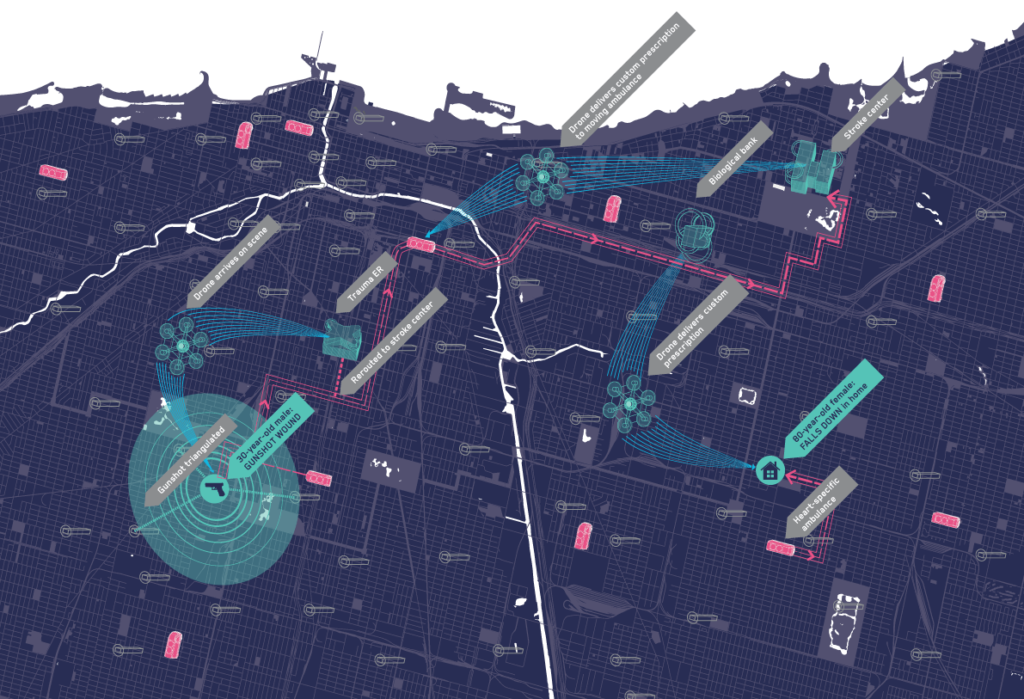Trauma Timeline
Chicago, IL

-
30-year-old male: GUNSHOT WOUND00:00:00
A 30-year-old male is shot on a public street corner in a drive- by shooting.
Acoustic sensors around town immediately pick up the unique sound signature and dispatch ambulances and medical drones to the scene.
-
00:00:30
Self-driving ambulances patrol the city, using movement algorithms called Lévy flights, which are inspired by natural foraging patterns and immune cells. An ambulance specifically outfitted for gunshot and trauma is dispatched to the scene.
-
00:01:00
Drones arrive within one minute, feeding live video to the ambulance and law enforcement. If the scene is deemed safe and an escalation is necessary, a telepresent team of EMTs with access to the drone feed begin coordinating a plan.
-
00:03:00
The ambulance arrives within three minutes, as other networked self- driving cars and street lights clear the way. The ambulance drives above the patient, cocooning him, and he is robotically raised into the ambulance and identified. Patient’s biological bank is alerted that he has been injured. Immediately, across the city, the patient’s own engineered immune cells and stem cells are unfrozen.
-
00:05:00 – 00:10:00
Patient is injected with a nanoparticle contrast agent and rapidly analyzed using mobile imaging technology and AI- assisted triage. Surgeons at a nearby OR, coordinated by the strategic team of virtual EMTs, begin prep and videoconference into the ambulance.
-
00:10:00 – 00:15:00
En route, nanosensors, imaging, and AI detect a trauma-induced stroke. The patient is immediately placed into hypothermia and the ambulance is rerouted to a nearby specialized stroke center at the behest of the virtual EMT team. An AI anesthesia machine puts the patient under.
-
00:20:00
Drones from the biological bank deliver the patient’s own engineered immune cells and stroke drugs to the moving ambulance. They are administered immediately. A neuro-surgical and trauma team coordinate the joint surgical plan for complications from gunshot and stroke.
-
00:25:00
Within 30 minutes, the patient is in surgery.
-
80-year-old female: FALLS DOWN in home00:00:00
An 80-year-old woman previously determined to be at high risk of heart attacks falls in her home, and can’t get up.
-
00:02:00
Her medically provided shoes are equipped with sensors that alert emergency response dispatchers within two minutes.
-
00:02:30
A self-driving ambulance specifically equipped and staffed with EMTs trained for heart attacks is dispatched.
-
00:03:00
While en route, paramedics in the ambulance review her medical records, which are streamed to a computer in the vehicle. A bracelet she wears is simultaneously sending her vital information to the ambulance, where it is being analyzed algorithmically.
-
00:04:00
Drones are dispatched to her house with any medication she may need and may have been prescribed in the past, based on her records.
-
00:05:00
The ambulance arrives and paramedics begin stabilizing her and assessing her physically, assisted by the analysis of vital information they received on the way.
-
00:06:00 – 00:10:00
With the help of a mobile imaging device, paramedics confirm a suspected diagnosis of a small heart attack, administer medication, and send the image and information to her doctor for follow-up.
-
00:12:00
Paramedics restore the woman to a comfortable situation and dispatch a home health aide who arrives within 10 minutes to provide basic care while she waits for follow-up from her doctor.
She never visits the hospital or sees the inside of an ambulance.
